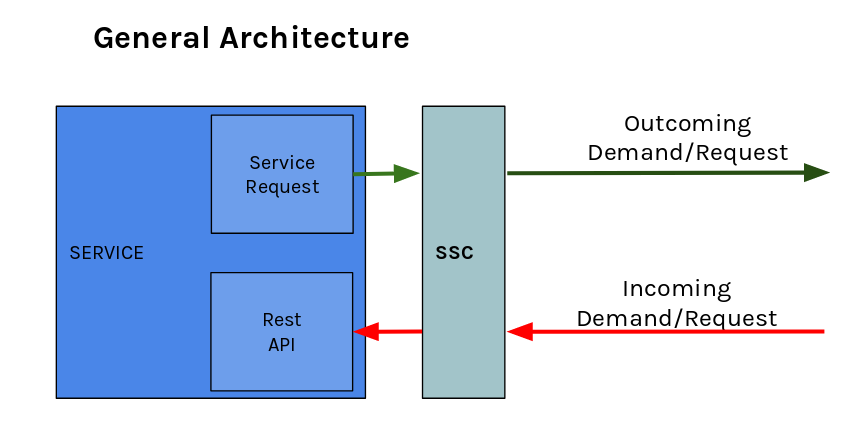Future Public repository, containing the SSC prototype. w to add!
The SeaSwimConnector is developed using:
Use maven to compile the source and generate the last version .
cd seaswim-connector
mvn clean package
cd ..
cd ssc-client
mvn clean package
cd..Ssc is a software service component that works like:
- Proxy web server:
- Listen on a configurable port and intercept the incoming calls.
- Check the the STM certificates validity implementing the two way Mutual TLS authentication mTLS
- Redirect the incoming call to a configurable internal port
- API that enable to:
- Communicate to Identity Registry Requests
- Set of main request to the identity registry
- Communicate to Service Registry Requests
- Set of main requests to te Service Registry
- Implementing the OpenIdConnect protocol
- Execute REST calls to other STM web services:
- add to each request the service certificates needed by the STM HTTPS/TLS authentication defined by STM
- Communicate to Identity Registry Requests
ssc
|- seaswim-connector-x.x.x.jar
|- application.properties
|- keystores
|-stm-service-keystores.jks
|-mc.truststore.jks
The described deploy structure describe :
- Executable: jar executable file
- Configuration: application.properties: this file contain the SSC configurations
- Java KeyStores: java components used to store the certificates information (Root Certificate MCP and Service Certificate)
- Java Keystores are used to contains:
- The Application Service certificate downloaded from the Maritime Connectivity Platform
- The Maritime Connectivity Platform root certificates: this certificate is used by the ssc to verify the incomings call certificates. If are valids STM certificates
(based on this tutorial)
1 Configure SSL to use your own CA authority
cd <working-dir>
mkdir ssl
cd ssl
mkdir certs private
echo "100001" > serial
touch certindex.txt
<copy openssl.cnf file to current directory>2 Create self-signed CA certificate and generate its PEM file.
openssl req -new -x509 -extensions v3_ca -keyout private/cakey.pem -out cacert.pem -days 365 -config ./openssl.cnf3 Create server certificate:
- Create a certificate request for the server
- Create the certificate using our CA authority
- Export server certificate in PKCS12 format
Important: The "Common Name" must match the domain that will be presenting the certificate e.g. localhost
openssl req -new -nodes -out server-req.pem -keyout private/server-key.pem -days 365 -config openssl.cnf
openssl ca -out server-cert.pem -days 365 -config openssl.cnf -infiles server-req.pem
openssl pkcs12 -export -in server-cert.pem -inkey private/server-key.pem -certfile cacert.pem -name "Server" -out server-cert.p124 Create client certificate
openssl req -new -nodes -out client-req.pem -keyout private/client-key.pem -days 365 -config openssl.cnf
openssl ca -out client-cert.pem -days 365 -config openssl.cnf -infiles client-req.pem
openssl pkcs12 -export -in client-cert.pem -inkey private/client-key.pem -certfile cacert.pem -name "Client" -out client-cert.p12 "KeyStores provide credentials, TrustStores verify credentials."
1 Create server keystore with the server certificate
keytool -importkeystore -deststorepass cimne-server -destkeypass cimne-server -destkeystore server_keystore.jks -srckeystore server-cert.p12 -srcstoretype PKCS12 -srcstorepass cimne-server -alias server2 Create server truststore with the CA certificate
keytool -import -v -trustcacerts -keystore server_truststore.jks -storepass cimne-server -file cacert.pem -alias cacert3 Create client keystore with the client certificate
keytool -importkeystore -srckeystore client-cert.p12 -srcstoretype pkcs12 -destkeystore client_keystore.jks -deststoretype jks -deststorepass cimne-client4 Create client truststore with the server certificate
keytool -import -v -trustcacerts -keystore client_truststore.jks -storepass cimne-client -alias server -file server-cert.pemConfiguration example for the staging environment.
#Identity Registry using Certificates base path (URL)
stm.identityRegistry.x509.url=https://staging-api-x509.maritimecloud.net/x509/api
#Identity Registry using OpenId Connect base path (URL)
stm.identityRegistry.oidc.url=https://staging-api.maritimecloud.net/oidc/api
#Service Registry base path
stm.serviceRegistry.url=https://sr-staging.maritimecloud.net/api
#OPENID-CONNECT urls
stm.identityRegistry.openid.auth=https://staging-maritimeid.maritimecloud.net/auth/realms/MaritimeCloud/protocol/openid-connect/auth?
stm.identityRegistry.openid.token=https://staging-maritimeid.maritimecloud.net/auth/realms/MaritimeCloud/protocol/openid-connect/token?
## Logging for debug
logging.level.org.springframework= DEBUG
logging.level.org.apache.http=DEBUG
# SSC configuration server1
connector.name=${name:ssc-vis001}
# properties for application server's configuration
# enables 2-way SSL authentication always on "need"
server.ssl.client-auth=need
## KEYSTORE SETTINGS ##
# keystore (private key) location
server.ssl.key-store=file:keystores/vis001.jks
# keystore password
server.ssl.key-store-password=changeit
# private key password p12
server.ssl.key-password=changeit
## TRUSTSTORE SETTINGS - trusted certificates ##
# truststore (trusted certificates) location
server.ssl.trust-store=file:keystores/mc-truststore-password-is-changeit.jks
#truststore password
server.ssl.trust-store-password=changeit
## OPEN ID CONNECT CONFIGURATION ##
#redirectPort must begin with 9 (IdentityRegistry requirement)
openid.redirectPort=9991
#redirectURI must begin with http://localhost:9 (IdentityRegistry requirement)
opeind.redirectURI=http://localhost:${openid.redirectPort}/openid/auth
## SSC PORTS CONFIGURATION ##
## |VISCIMNE1:5501| <-- forwarded_to -- |SSC:8801| <-- incoming calls
## |VISCIMNE1:5501| --> use private ssc |SSC:7701| --> outGoing calls
# SSC listening Proxy port
server.port=8801
# SSC Private interface
privateAPI.port=7701
# SSC private interface use HTTP
privateAPI.secure=false
# configuration of the service associated to the SSC - the VIS1
service.endpoint=http://localhost:5501
Execute server1 default application properties . The ssc will take the application properties in the same directory
java -jar seaswim-connector/target/seaswim-connector-0.0.1.jarExecute server1 with a a custom located application properties file.
java -Dspring.profiles.active=/path/to/server1 -jar seaswim-connector/target/seaswim-connector-0.0.1.jar